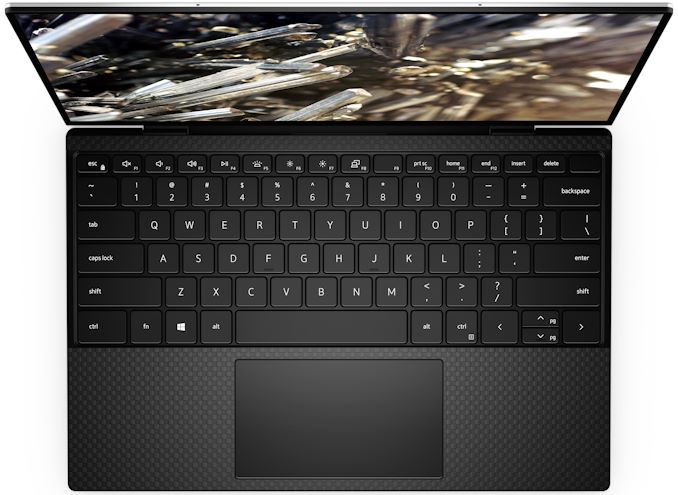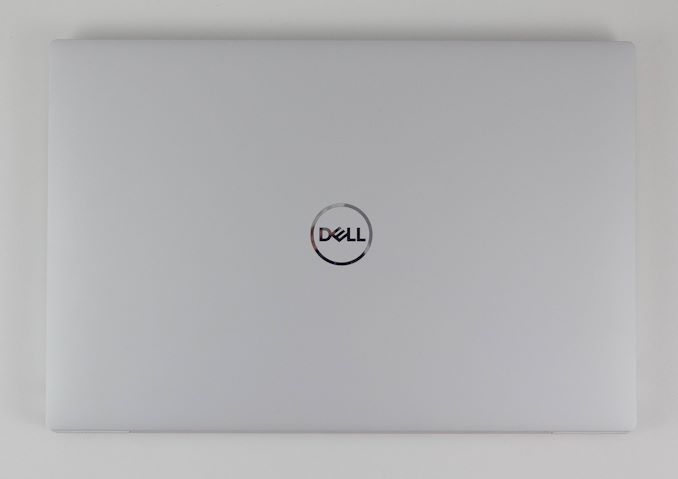The Dell XPS 13 (9300) Review: Return of the King
by Brett Howse on July 16, 2020 10:00 AM ESTDesign
Dell pioneered the thin-bezel laptop, but that does not mean they did not have room to improve on their original design over the years. The first several generations featured a webcam at the bottom of the panel, which was flattering to no one. With the proliferation of video chat, such a decision would be a major negative to many people. But thankfully Dell solved that particular issue a couple of generations ago, and the new model continues to pack a 720p webcam in the correct location above the display, with only a slightly taller top display bezel to accommodate the camera. And speaking of the display bezel, Dell has tweaked their design language slightly over the XPS 13 2-in-1, with both the black and white models both featuring a black display bezel on the clamshell XPS 13, which helps it disappear into the background a bit easier than the white bezel on the 2-in-1.

The XPS 13 in Platinum Silver with black carbon fiber
Another nice change over the 2-in-1 version is that Dell is not using their MagLev keyboard design, instead outfitting the XPS 13 with a more traditional scissor-switch keyboard with 1.0 mm of travel. The MagLev has a very short throw, whereas I find the traditional keyboard to be much more reassuring to use.
Dell is offering the XPS 13 in the same color choices as the 2-in-1 as well. The Platinum Silver model features a black carbon fiber keyboard deck with a soft-touch coating, while the Arctic White model features a woven fiber keyboard deck which Dell has treated with a stain and UV resistant coating, to prevent the deck from yellowing with age. The Arctic White is only $49 more, and certainly makes a statement, although it still suffers from the same issue as all white-on-white laptops with white backlighting, which is that the keyboard backlighting can wash out the keys in a bright room. That is a fairly minor negative though, for an otherwise fantastic finish.
The XPS 13 also features an excellent trackpad, offering a very smooth finish, and good precision. Laptop trackpads have come a long way, and part of that is the standardization on the Microsoft Precision touchpad drivers, which Dell employs here.
Dell has eschewed the use of USB Type-A ports, instead offering just a single USB Type-C port on each side of the laptop. This in turn is paired with a 3.5 mm headset jack on the right, and a micro SD card reader on the left. Although the XPS 13 lacks ports in numbers, it somewhat makes up for that with both USB ports supporting Thunderbolt 3, including power delivery. It is unfortunate that the Type-C port has found itself to be so confusing in its capabilities, but with the XPS 13 supporting the full range of protocols, as well as four lanes of PCIe on both ports, that at least is not a liability here. Dell does include a Type-C to Type-A adapter in the box as well, for those that require the larger port. By including power delivery on both sides of the laptop, that also means the XPS 13 can charge on either side, which can be very handy when moving the laptop from place to place.
Dell’s design ethos with their XPS lineup has converged across the entire range of XPS laptops, and with great success. The CNC milled aluminum bodies, thin bezels, compact designs, and lightweight chassis make for some of the most compelling devices in the industry. Moving to a 16:10 aspect ration on their XPS line has been yet another design win for Dell, and helps provide the excellent 91.5% screen to body ratio found on this XPS 13 notebook by further shrinking the bottom bezel. Dell has sculpted a clean, sleek, and functional device, and while the rest of the industry has also adopted the thin-bezel design, Dell has really mastered it.













224 Comments
View All Comments
TheinsanegamerN - Thursday, July 16, 2020 - link
If tiger late is as impressive as ice lake the ryzen 4700u will retain a significant advantage in performance, and I'll believe it releases when I see it.Deicidium369 - Thursday, July 16, 2020 - link
Much more impressive. 4C Tiger Lake is 17% slower than 8C Renoir - and Xe LP is at least 2x as fast as Gen11 (in Ice Lake) and performs as well as a Nvidia MX350 (hence why Nvidia is pushing out the Turing MX450) - which wrecks the ancient Vega.So double the cores and a whopping 17% perf advantage - and much slower iGPU - are we sure that AMD understands the laptop market?
rhysiam - Thursday, July 16, 2020 - link
You are doing some gold-standard cherry picking here. Which chart gets you this "17% slower" number you keep quoting as if it's gospel? The 15W thermal envelope is the limiting factor here, so "double the cores" won't net you anywhere near double the performance, nor are they supposed to.According to this very review, lightly threaded tests show the 4700U on par with the similarly clocked Ice Lake. They are neck and neck. IPC is very close between Zen 2 and Sunny Cove.
Highly threaded workloads are dominated by AMD:
CB: 4700U is 52% faster
HB(software): 4700U is 71% faster
HB(hardware): 4700U is 79% faster
7-Zip(comp): 4700U is 34% faster
7-Zip(decomp): 4700U is 40% faster
Remember that the 4700U is **not** the top SKU (though admittedly the 4800U isn't much faster).
Again - where is this "17%" coming from if not deceptively cherry picked?
Tiger Lake looks to have a massive GPU, but what are we looking at CPU wise? A few % IPC and very small clock bump? Maybe Intel squeeze out a tiny single threaded lead, while still getting trashed in multi-core workloads - in exchange for a better iGPU.
Spunjji - Friday, July 17, 2020 - link
@rhysiam - He's basing his claims on an early benchmark leak that does indeed suggest a healthy single-thread lead for Tiger Lake and a moderate multi-core deficit. It doesn't look to be a particularly unreliable leak - apparently comparing like-for-like in terms of chassis - but it's still just the one leak. There are also leaks implying a far less dramatic advantage for the Xe LP GPU, but he's not citing those.When it comes to Deicidium, information suggesting Intel superiority is taken as gospel and information suggesting otherwise is discarded. He spent the months leading up to Renoir's release refusing to believe any of the benchmark leaks favouring AMD and hammering on how unreleased products don't matter. Go figure.
Deicidium369 - Friday, July 17, 2020 - link
Yeah, boy as I wrong - that Great Renoir can compete with an almost year old design! That is unbelievable. With such massive year over year IPC increases - would only be fair to compare the Great Renoir with Alder or Meteor Lake.Too bad AMD marketing never pans out and when the fanboys get it - and filter it through their fever dreams - it is even more disappointing when released - The Another Marketing Deception product release
HYPE HYPE HYPE LAUNCH SIGH! NEXT (or compare to last years outgoing CPU)
Korguz - Friday, July 17, 2020 - link
just like you do as well Deicidium369. so look who's talking, little childByte - Friday, July 17, 2020 - link
I guess competitive means you are still alive in a two horse race. Doesn't matter if your horse overheated on the side of the road.Santoval - Friday, July 17, 2020 - link
If Tiger Lake is still capped at 4 cores (and apparently both the Y and U variants are, though the -H variant will probably have up to 6 cores) it will not be able to compete with AMD's APUs in *CPU* performance. According to some leaks though Tiger Lake's Xe iGPU outperforms the (very) old Vega based iGPU that for some inexplicable reason (to avoid internal competition with their lowest end Navi graphics cards?) AMD decided to add to their 4000 APU series.Well, Xe hasn't even been released yet and Vega was released 3 full years ago, so if Xe couldn't even outclass (barely apparently) a 3-year old iGPU Intel would be in deep trouble. Tiger Lake might outperform AMD's APUs in single thread performance, but that doesn't matter as much anymore. The question is how much Intel managed to raise the IPC and the clocks of Tiger Lake over Ice Lake, but it's not "doubtful" at all that AMD's APUs will be in most ultrabooks by early next year. Only people who were sleeping in a technological cave for the last 3 years would think that.
Deicidium369 - Friday, July 17, 2020 - link
inclusion of Vega was AMD's choice.Ice Lake had a 30% increase in IPC (the quip about, at the expense of lower clocks is meaningless) and with improved 10nm+ and architectural advanced in Willow Cove equate to an actual IPC increase, not just one in marketing materials.
4 cores can easily equal AMD 8 cores. These are ultralights - they are not DTR - 4 superior cores + superior graphics are the best mix - not 8 cores an ancient Vega iGPU.
They won't be in premium devices - it is not their market - Lenovo is as close as they will come - not worth the OEMs to design around a niche APU that won't sell in profitable numbers.
OEMs seem to not want to make the investment into AMD designs, no one is asking for them, and they have no advantage over the well established, steady (Intel never dropped out of sight for more than a decade) and reliable Intel.
MOAR COARZ. LMAO.
Korguz - Friday, July 17, 2020 - link
lets see you post proof of this, Deicidium369. if not, its just your usual pro intel, anti amd bs, as you always post.